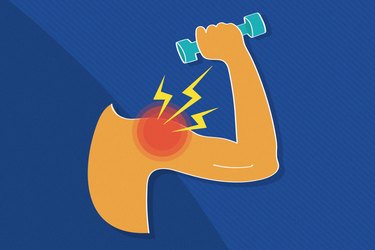
Whether your goal is to become a stronger athlete or build bigger muscles, lifting weights can support healthy joints, improve your heart health and promote weight loss.
It's tempting to hit the squat rack every single day if you're seeing (or seeking) these gains, but like all things, too much of a good thing can be bad. If you don't allow your muscles time to recover, lifting weights every day can backfire.
Video of the Day
Video of the Day
Here's exactly what happens to your body when you lift every day and how you can strength train safely to reach your goals.
Benefits of Lifting Weights Every Day
It can be good to lift weights every day, depending on what you hope to get out of strength training daily.
Your Muscles Grow Bigger and Stronger
Any lifting routine, daily or otherwise, depends on your training goals. For example, if you want to be able to lift heavier weights, your strength-training program will look different from someone's who wants to grow visibly bigger muscles, also known as hypertrophy, or develop muscle endurance to complete more reps before they fatigue.
"Before I give anyone a strength plan, I always tackle what their goal is," says Prince Brathwaite, a National Academy of Sport Medicine (NASM)-certified personal trainer and owner of Trooper Fitness.
For example, are you lifting to build biceps or to hit a new bench press record? "There will be some overlap in rep schemes and phasing, but for the most part, the programs vary in three different ways: volume, effort/intensity and rest," Brathwaite says.
That's because the muscle fibers you engage and how you do so differs by goal.
First, a refresher: You have two main types of muscle fibers: type I (slow-twitch) and type II (fast-twitch), according to the American Council on Exercise (ACE). Type I muscle fibers require steady oxygen intake to activate during endurance exercises, like running, biking and swimming. Type II muscle fibers are used during explosive movements like heavy lifts when the task at hand is more than type I fibers can handle alone.
Following a higher rep range at a lower intensity will help you train your type I muscle fibers. A lower rep range at a higher intensity will help you train your type II muscle fibers for hypertrophy, explains Kristen Lettenberger, PT, DPT, a certified sports and conditioning specialist (CSCS) at Bespoke Treatments in New York City.
Training Volume by Goal
Goal | Reps | Intensity |
|---|---|---|
Muscular endurance | 12 to 15 | 67% of one-rep max |
Hypertrophy | 6 to 12 | 67 to 85% of one-rep max |
Power | 1 to 5 | 75 to 90% of one-rep max |
You Burn Fat and Could Lose Weight
Lifting weights every day can support your weight-loss goals by helping you burn calories and reducing overall body fat. Although you can't spot-reduce specific areas, like your belly, strength training promotes body fat loss by building lean muscle and increasing your metabolic rate.
"Muscles burn more calories at rest than fat and will burn calories even after the workout is done, [potentially] for up to 48 hours," Lettenberger says. "With people who consistently weight train, they will have physiological changes that include decreased percent body fat, increased lean body mass and increased bone density."
The extended calorie burn Lettenberger refers to is due in part to a process called excess post-exercise oxygen consumption (EPOC), also known as workout afterburn, according to the ACE, a measure of the oxygen it takes for your body to recover. Taxing your body during resistance training means you need more oxygen afterward to restore normal metabolic function, and this process burns calories.
Good news if you love to lift: Research suggests resistance training may have superior EPOC-enhancing perks compared to steady-state aerobic training.
A very small June 2015 study in the Journal of Research Quarterly for Exercise and Sport found resistance training (as well as interval training) produced a higher resting metabolic rate 12 hours and 21 hours after exercise than steady-state aerobic exercise.
To increase the afterburn effect in your everyday lifts, add some compound exercises, which challenge multiple muscle groups and joints at once, and make your rest intervals in between sets shorter.
Keep in mind, however, you don't have to lift weights every day to lose weight — cardio can be part of an effective plan, and you can do less frequent strength sessions. (Plus, don't forget stress levels, sleep and genetics also affect your body weight.)
Your VO2 Max Might Improve
Cardio endurance may sound like a bit of a surprising benefit of weightlifting daily.
"When you strength train, you are increasing muscle activation, which demands a constant supply of oxygen-rich blood, thus improving your cardiovascular endurance," Brathwaite says.
Although lifting weights won't improve your VO2 max — a measure of aerobic fitness — the same way that circuit training and HIIT workouts can, incorporating some strength training into these routines can help increase your aerobic capacity, Lettenberger says.
"Some ways you can integrate the two [HIIT and strength training] is by performing two to four exercises using a muscular endurance scheme of high reps and low weights with fewer sets and 30 seconds of rest in between exercises," Lettenberger says.
Following this rep scheme will keep your heart rate elevated, allowing it to drop only slightly between sets, resulting in a strength-training interval workout. For example, Lettenberger says you can do kettlebell swings, push-ups and pull-ups back-to-back.
Your Bones Stay Strong
After the age of 30, you start to lose muscle mass by 3 to 5 percent per decade, a process called sarcopenia, according to Harvard Health Publishing. This loss in muscle mass leads to less mobility and an increased risk of falls and fractures. Sarcopenia is largely the result of changes in hormones due to aging.
The good news is you can help prevent sarcopenia by lifting weights regularly (although days off are still important). Focus especially on strength-training exercises that stimulate your fast-twitch muscle fibers, because most of the muscle loss you experience from sarcopenia affects those type II fibers.
According to a May 2013 study in Experimental Gerontology, reduced muscle mass from aging is largely due to smaller type II muscle fiber size. Essentially, if you don't use them, you lose them.
Based on Wolff's law by German surgeon and anatomist Julius Wolff, your bones will adapt to the stress that they are placed under (read: load), so by gradually increasing the load, your bones will adapt to withstand more stress.
"One of the best ways to improve your mobility, which is the amount that a joint can move in space, as well as your flexibility — the amount that a tissue can extend — is by moving through a full range of motion with an external load, aka weights," Lettenberger says.
Potential Drawbacks of Lifting Weights Every Day
The impact of lifting weights daily isn't always positive. Keep these risks in mind before weightlifting daily.
You Might Hit a Plateau
If your daily weightlifting routine doesn't allow ample time for a healthy diet, recovery and sleep, you may be setting yourself up for overtraining and injuries, which can lead to a strength and/or weight-loss plateau, Lettenberger says.
She recommends resting one to two days in between weight-training sessions and varying the muscles you're targeting in each session to allow for enough recovery time.
"Hitting a plateau in weight training may be that you are overtrained or burned out. This can be caused by little to no rest, which is crucial for your body to repair itself and heal," Lettenberger says.
"If you find yourself hitting a wall, it may be time to re-look at your program," she says. "Some ways you can prevent hitting a plateau are taking your rest days seriously, keeping your programs simple and focusing on the main lifts and concepts of push, pull, hinge and carry."
During your recovery days, make sure to truly rest. Light stretching, mobility work, foam rolling and yoga are great ways to ease sore muscles and promote healing, while still staying active.
Paying careful attention to your diet is also key. Make sure you're refueling your body with adequate amounts of protein, carbs and healthy fats to heal and power upcoming workouts.
To truly break through a plateau, eventually you'll need to up the intensity — and you'll be better prepared for new challenges with proper rest.
You Could Get Hurt
Resistance training can become detrimental if you're overdoing it or if you don't address any muscle imbalances, Brathwaite says. Lifting weights every day, especially the same muscle groups and joints, can lead to muscle overuse injuries.
In fact, muscle overuse injuries, like biceps tendinitis, don't just happen from repetitive movements. They can happen from training too frequently and improperly loading the joint.
"Choosing the load is important, as well as recovery for the tissues. If you move too quickly into a heavy load without proper warmup and progression, you can risk injury," Lettenberger says. "It's important if you're new to weight training to clear it with your health care provider or a physical therapist."
Lettenberger also advises working with a certified trainer to ensure you're lifting weights with good form and are addressing any imbalances that might lead to injury.
How to Incorporate Weightlifting Into Your Daily Routine
While lifting weights every day will help you reach your strength and power goals, it's important to make sure you let your muscles properly recover, so it's best to avoid training the same muscle group every day.
If your goal is to build muscular endurance, recover at least 24 hours between workouts. If you're seeking hypertrophy, rest for 24 to 72 hours. Take 48 to 72 hours off if you're training for strength and power, according to the ACE.
"When you strength train, you tear muscle fibers, but that is part of the growing process," Brathwaite says. "You shouldn't lift the same muscle group every day because the muscle needs to heal in order to rebuild."
For example, you can focus on training your lower body, including your quads, hamstrings, calves, hip flexors and glutes, every Monday, and then your chest and back muscles on Tuesdays. "This way one muscle group is recovering while the other is experiencing duress," Brathwaite says.
So, Should You Lift Weights Every Day?
Ultimately, whether you should lift weights every day comes down to your goals and what muscle groups you're targeting. Training the same muscle groups every day simply doesn't allow for adequate recovery.
"Lifting weights every day is safe so long as you are resting other muscle groups," Brathwaite says. Split routines, where you train different muscle groups on different days, are much better for this than doing a full-body workout every day.
If you don't give your muscles enough rest, you run the risk of an injury or a plateau. Lifting weights every day can exacerbate the overall impact on your body, making it harder to adapt to the strain.
"Breaking through plateaus is as simple as resting and taking time off," Brathwaite says.
"For beginners, I would say one to two days in between sessions," Lettenberger says. "If you are more advanced and are training four to six days a week, I would recommend hitting different muscles on your back-to-back days, still allowing one to two days between sessions working the same muscle group."
You can also experiment with using lighter weights (or just your body weight) or keeping your workouts really short. These 5-minute routines, for example, are safe to do every day.
- American Council on Exercise: "Muscle Fiber Types: Fast-Twitch vs. Slow-Twitch"
- American Council on Exercise: "7 Things to Know About Excess Post-Exercise Oxygen Consumption (EPOC)"
- Journal of Research Quarterly for Exercise and Sport: "EPOC Comparison Between Isocaloric Bouts of Steady-State Aerobic, Intermittent Aerobic, and Resistance Training"
- Harvard Health Publishing: "Preserve Your Muscle Mass"
- Experimental Gerontology: "The Decline in Skeletal Muscle Mass with Aging is Mainly Attributed to a Reduction in Type II Muscle Fiber Size"
- ICOI: "Wolff's Law"
- American Academy of Orthopaedic Surgeons: "Biceps Tendinitis"
- American Council on Exercise: "How to Select the Right Rest Intervals and Post-Training Recovery for Your Clients"
- American Council on Exercise: "How to Select the Right Intensity and Repetitions for Your Clients"









